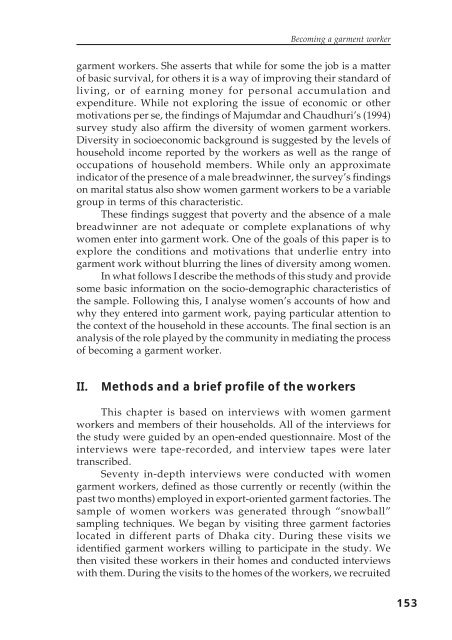Women's Employment - United Nations Research Institute for Social ...
Women's Employment - United Nations Research Institute for Social ...
Women's Employment - United Nations Research Institute for Social ...
You also want an ePaper? Increase the reach of your titles
YUMPU automatically turns print PDFs into web optimized ePapers that Google loves.
Becoming a garment worker<br />
garment workers. She asserts that while <strong>for</strong> some the job is a matter<br />
of basic survival, <strong>for</strong> others it is a way of improving their standard of<br />
living, or of earning money <strong>for</strong> personal accumulation and<br />
expenditure. While not exploring the issue of economic or other<br />
motivations per se, the findings of Majumdar and Chaudhuri’s (1994)<br />
survey study also affirm the diversity of women garment workers.<br />
Diversity in socioeconomic background is suggested by the levels of<br />
household income reported by the workers as well as the range of<br />
occupations of household members. While only an approximate<br />
indicator of the presence of a male breadwinner, the survey’s findings<br />
on marital status also show women garment workers to be a variable<br />
group in terms of this characteristic.<br />
These findings suggest that poverty and the absence of a male<br />
breadwinner are not adequate or complete explanations of why<br />
women enter into garment work. One of the goals of this paper is to<br />
explore the conditions and motivations that underlie entry into<br />
garment work without blurring the lines of diversity among women.<br />
In what follows I describe the methods of this study and provide<br />
some basic in<strong>for</strong>mation on the socio-demographic characteristics of<br />
the sample. Following this, I analyse women’s accounts of how and<br />
why they entered into garment work, paying particular attention to<br />
the context of the household in these accounts. The final section is an<br />
analysis of the role played by the community in mediating the process<br />
of becoming a garment worker.<br />
II.<br />
Methods and a brief profile of the workers<br />
This chapter is based on interviews with women garment<br />
workers and members of their households. All of the interviews <strong>for</strong><br />
the study were guided by an open-ended questionnaire. Most of the<br />
interviews were tape-recorded, and interview tapes were later<br />
transcribed.<br />
Seventy in-depth interviews were conducted with women<br />
garment workers, defined as those currently or recently (within the<br />
past two months) employed in export-oriented garment factories. The<br />
sample of women workers was generated through “snowball”<br />
sampling techniques. We began by visiting three garment factories<br />
located in different parts of Dhaka city. During these visits we<br />
identified garment workers willing to participate in the study. We<br />
then visited these workers in their homes and conducted interviews<br />
with them. During the visits to the homes of the workers, we recruited<br />
153
















